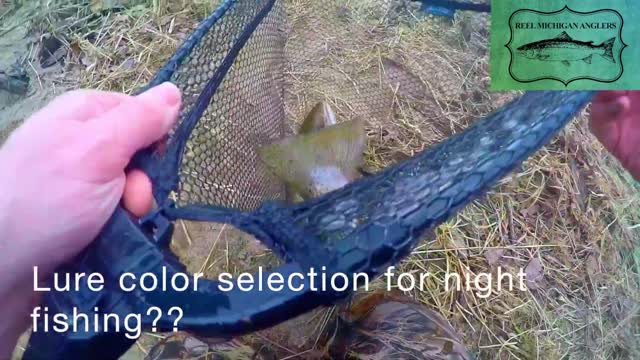Premium Only Content

How Do I Choose The Right Lure Color? / My 6 Rule Guide To Choosing Lure Colors
Have you ever wondered does the color of your lure matter? Or how do I choose the right lure color? Or What is the best color lure to use in muddy water? Maybe you have wondered about lure color selection for night fishing or wondered When should I use dark fishing lures? If so this is the video for you!
In my 6 rule guide to choosing lure colors I will cover all of that and more!
How do I know what color lure to use? Trial and error mixed with researching and reading. I would love to meet and pick the brain of someone who studies fish eyes to learn a thing or 2 more but until then this is my basic guide on how to choose lure color.
Ill include the script I wrote for this video below so you can reference it at your convenience.
How to chose lure Colors
Considerations.
Not all fish see color,
Not all fish see color the same way,
not all fish see uv,
Do some research on the specific fish you are targeting.
Colors can not be seen after dark. Colors will appear in different shades of gray to black.
Sight is just one sense a fish uses to forage for food. Hearing sight touch taste and smell are all senses that fish use to detect prey.
Rule 1: Use natural looking, light colored lures for clear water and or sunny days.
This is a match the hatch tactic and you are mimicking the fishes natural food choices. Wether using Minnows worms crayfish shrimp frogs turtles bugs and crustaceans ect. The goal is to Match the color of these menu items as closely as you can.
If you have no idea what the forage is or what color to use focus on clear or opaque and green pumpkin soft plastics and lures that reflect sunlight like a silver or gold blade spinner or shiny crank bait.
Rule 2: Use very bright or very dark lures for dirty water or cloudy days. The goal here is to contrast the color of the water.
With high dirty water a fish’s vision and ability to smell is also impaired and therefore they rely more heavily on vibration to detect their prey but a brightly colored object in the water is likely to catch their eye and increase interest.
Chartruse, hot pink, white, orange, black and fire tiger as well as Black Blue and Purple are all Great for creating a strong contrast in stained water or low light situations.
Rule 3: Take matching the Hatch to the next level. Being aware of the life cycle of your most common bait imitations will help you know when and where to use witch imitation and what color variation.
If you are Fishing crayfish imitations you want to keep in mind what color the crayfish is as they change colors throughout the season from light browns to bright red’s and black or blue.
Egg imitations can range from white or yellow to hot pink and bright orange as the actual eggs very in color depending on how much time they have spent in the water what type of egg it or which species it came from and many other factors. Different fly hatches during different seasons and and each one looks different during its various stages therefore The hot bug patterns Are constantly changing.
Rule 4: “Trigger the fish”
This works well with territorial fish and fish pre through post spawn. Sometimes the goal is to anger the fish rather than tricking It into eating the goal is instead to provoke its aggressive nature. Obnoxious bright colors or anything that resembles a threat to the fishes territory.
Arguably Genetic predispositions exist toward certain colors
Some believe steelhead like pink because they naturally feed on shrimp in their historical habitat. I believe pink and orange and chartreuse triggers their instinct to eat other fishes eggs.
There is lots of evidence supporting the fact that Bass love the color red and tackle shops sell lots of red hooks because of this belief that it triggers their aggression. Red throats on jerk baits mimic wounded bait fish and predators always like an easy target.
Night Fishing.
Rule 5: use black, purple or dark blue lures. The theory is that these colors provide a more distinct profile when silhouetted against the lighter background of the water's surface.
Imagine a deer in headlights all it sees is the bright light but if you stood between the car and the deer there would be an absence of light where your body blocks the light which would make you visible to the deer. I think this is why top water at night is popular because the surface disturbance along with contrast of the lure against the moonlight.
Rule 6: On the flip side colors like chartreuse and white reflect moonlight as well as artificial light found in cities or public parks and dams making them more visible to the fishes eye.
These rules apply to many but not all fish and I primarily fish for Pike, Bass, Walleye, Trout, Salmon, Steelhead, Catfish, Crappie and other panfish and have found these rules to apply for all species in my experience. Don't forget that sight is just one of many senses a fish uses to detect prey. In my opinion smell and vibration are as important if not more.
-
 11:14
11:14
Michigan fishing videos
2 years ago $0.29 earnedMichigan Coho Salmon Fishing In The River / Float Fishing For Salmon With Skein / Coho Bobber Downs
3.85K5 -
 3:44:08
3:44:08
SavageJayGatsby
6 hours ago🌊🐠 Subnautica: Nitrox Sunday 🐚💙
233K10 -
 24:34
24:34
HaileyJulia
9 days agoThis Christian Morning Routine Changed Everything for Me
12.2K3 -
 LIVE
LIVE
Putther
4 hours ago $2.20 earned🔴LAZY SUNDAY STREAM!! (GTA + MORE)
188 watching -
 30:13
30:13
Congressman Randy Fine
4 hours agoCongressman Fine Virtual Press Conference on the Democrat Shutdown
31.7K53 -
 LIVE
LIVE
GritsGG
5 hours agoQuads Into Ranked Top 30! Most Wins in WORLD! 3734+!
111 watching -
 53:29
53:29
Tactical Advisor
6 hours agoUnboxing New Guns | Vault Room Live Stream 042
114K10 -
 56:20
56:20
Steven Crowder
1 day agoEXPLAINED: Is America Headed For a Market Crash?
160K108 -
 LIVE
LIVE
S0lidJ
3 hours ago🟢Live -S0lidJ - This Game Is A Blast
21 watching -
 21:38
21:38
Professor Nez
7 hours agoHE'S BACK! Elon Musk EVISCERATES Biden Judge Over Big Balls Verdict
30.5K55